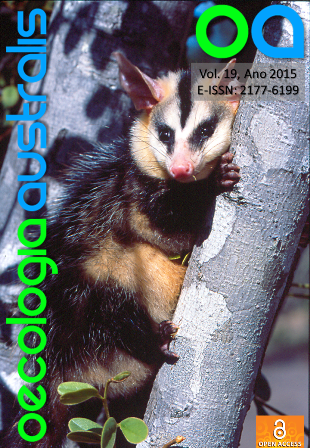Morphometrics of the largest New World marsupials, opossums of the genus Didelphis (Didelphimorphia, Didelphidae)
DOI:
https://doi.org/10.4257/oeco.2015.1901.08Keywords:
Didelphidae, Didelphis, Morphological evolution, Morphometrics, Size, ShapeAbstract
Opossums of the genus Didelphis include the largest living species of New World marsupials. Although species of the genus have been morphometrically analyzed separately in several studies, size and shape variation within the genus has never been assessed with all species simultaneously. Here I provide the first comprehensive analysis of diversification in size and shape in the skull and mandible in the living species of Didelphis. I established a set of landmarks to capture the size and shape of the skull and mandible, using a sample of ca. 350 specimens, and compared species in size, and assessed the major axes of shape variation and differentiation through Principal Components and Canonical Variates analyses of the Procrustes coordinates of these landmarks. Additionally I assessed the effect of size on shape variation by regressing PC and CV scores onto centroid sizes. This analysis shows that almost all species can be distinguished in size, except for two species of white-eared opossums. Shape variation and diversification is also highly driven by size effects, as the most distinctive species in size, D. virginiana, is also the most distinctive species in shape, due to allometric shape changes. Major axes of shape variation are correlated with size, indicating that size plays a major role in the morphological diversification of the genus Didelphis, and these correlations are shared and conserved across species.
Downloads
Downloads
Additional Files
- camiladebarros, Figure 1. Landmarks.jpg (Português (Brasil))
- camiladebarros, Figure 2. PCA Dorsal.png (Português (Brasil))
- camiladebarros, Figure 3. PCA Ventral.png (Português (Brasil))
- camiladebarros, Figure 4. PCA Lateral.png (Português (Brasil))
- camiladebarros, Figure 5. PCA Mandibula.png (Português (Brasil))
- camiladebarros, Figure 6. CVA Dorsal.png (Português (Brasil))
- camiladebarros, Figure 7. CVA Ventral.png (Português (Brasil))
- camiladebarros, Figure 8. CVA Lateral.png (Português (Brasil))
- camiladebarros, Figure 9. CVA Mandibula.png (Português (Brasil))
- camiladebarros, Figure 10. Correlations CSxPCs.png (Português (Brasil))
- camiladebarros, Figure 11. Correlations CSxCVs.png (Português (Brasil))
- camiladebarros, Cover Letter Didelphis.pdf (Português (Brasil))
- camiladebarros, 956-6439-2-ED mod Nat.docx (Português (Brasil))
- camiladebarros, 956-6439-4-ED.docx (Português (Brasil))
- camiladebarros, 956-6439-5-ED.jpg (Português (Brasil))
- camiladebarros, 956-6439-6-ED.jpg (Português (Brasil))
- camiladebarros, 956-6439-8-ED.png (Português (Brasil))
- camiladebarros, 956-6439-9-ED.png (Português (Brasil))
- camiladebarros, 956-6439-10-ED.png (Português (Brasil))
- camiladebarros, 956-6439-11-ED.png (Português (Brasil))
- camiladebarros, 956-6439-12-ED.png (Português (Brasil))
- camiladebarros, 956-6439-13-ED.png (Português (Brasil))
- camiladebarros, 956-6439-14-ED.png (Português (Brasil))
- camiladebarros, 956-6439-15-ED.png (Português (Brasil))
- camiladebarros, 956-6439-16-ED.png (Português (Brasil))
- camiladebarros, 956-6439-17-ED.png (Português (Brasil))
- camiladebarros, 956-6439-18-ED.png (Português (Brasil))
- camiladebarros, 956-6439-19-ED.png (Português (Brasil))


